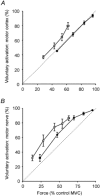Measurement of voluntary activation of fresh and fatigued human muscles using transcranial magnetic stimulation
- PMID: 12909682
- PMCID: PMC2343213
- DOI: 10.1113/jphysiol.2003.044099
Measurement of voluntary activation of fresh and fatigued human muscles using transcranial magnetic stimulation
Abstract
Recently, transcranial magnetic stimulation of the motor cortex (TMS) revealed impaired voluntary activation of muscles during maximal efforts. Hence, we evaluated its use as a measure of voluntary activation over a range of contraction strengths in both fresh and fatigued muscles, and compared it with standard twitch interpolation using nerve stimulation. Subjects contracted the elbow flexors isometrically while force and EMG from biceps and triceps were recorded. In one study, eight subjects made submaximal and maximal test contractions with rests to minimise fatigue. In the second study, eight subjects made sustained maximal contractions to reduce force to 60 % of the initial value, followed by brief test contractions. Force responses were recorded following TMS or electrical stimulation of the biceps motor nerve. In other contractions, EMG responses to TMS (motor evoked potentials, MEPs) or to stimulation at the brachial plexus (maximal M waves, Mmax) were recorded. During contractions of 50 % maximum, TMS elicited large MEPs in biceps (> 90 % Mmax) which decreased in size (to approximately 70 % Mmax) with maximal efforts. This suggests that faster firing rates made some motor units effectively refractory. With fatigue, MEPs were also smaller but remained > 70 % Mmax for contractions of 50-100 % maximum. For fresh and fatigued muscle, the superimposed twitch evoked by motor nerve and motor cortex stimulation decreased with increasing contraction strength. For nerve stimulation the relation was curvilinear, and for TMS it was linear for contractions of 50-100 % maximum (r2 = 1.00). Voluntary activation was derived using the expression: (1 - superimposed twitch/resting twitch) x 100. The resting twitch was measured directly for nerve stimulation and for TMS, it was estimated by extrapolation of the linear regression between the twitch and voluntary force. For cortical stimulation, this resulted in a highly linear relation between voluntary activation and force. Furthermore, the estimated activation corresponded well with contraction strength. Using TMS or nerve stimulation, voluntary activation was high during maximal efforts of fresh muscle. With fatigue, both measures revealed reduced voluntary activation (i.e. central fatigue) during maximal efforts. Measured with TMS, this central fatigue accounted for one-quarter of the fall in maximal voluntary force. We conclude that TMS can quantify voluntary activation for fresh or fatigued muscles at forces of 50-100 % maximum. Unlike standard twitch interpolation of the elbow flexors, voluntary activation measured with TMS varies in proportion to voluntary force, it reveals when extra output is available from the motor cortex to increase force, and it elicits force from all relevant synergist muscles.
Figures






Similar articles
-
Use of motor cortex stimulation to measure simultaneously the changes in dynamic muscle properties and voluntary activation in human muscles.J Appl Physiol (1985). 2007 May;102(5):1756-66. doi: 10.1152/japplphysiol.00962.2006. Epub 2007 Jan 11. J Appl Physiol (1985). 2007. PMID: 17218428
-
Maximal Voluntary Activation of the Elbow Flexors Is under Predicted by Transcranial Magnetic Stimulation Compared to Motor Point Stimulation Prior to and Following Muscle Fatigue.Front Physiol. 2017 Sep 20;8:707. doi: 10.3389/fphys.2017.00707. eCollection 2017. Front Physiol. 2017. PMID: 28979211 Free PMC article.
-
The effect of sustained low-intensity contractions on supraspinal fatigue in human elbow flexor muscles.J Physiol. 2006 Jun 1;573(Pt 2):511-23. doi: 10.1113/jphysiol.2005.103598. Epub 2006 Mar 23. J Physiol. 2006. PMID: 16556656 Free PMC article.
-
Transcranial magnetic stimulation and human muscle fatigue.Muscle Nerve. 2001 Jan;24(1):18-29. doi: 10.1002/1097-4598(200101)24:1<18::aid-mus2>3.0.co;2-d. Muscle Nerve. 2001. PMID: 11150962 Review.
-
Measurement of voluntary activation based on transcranial magnetic stimulation over the motor cortex.J Appl Physiol (1985). 2016 Sep 1;121(3):678-86. doi: 10.1152/japplphysiol.00293.2016. Epub 2016 Jul 14. J Appl Physiol (1985). 2016. PMID: 27418687 Review.
Cited by
-
Decline in voluntary activation contributes to reduced maximal performance of fatigued human lower limb muscles.Eur J Appl Physiol. 2012 Dec;112(12):3959-70. doi: 10.1007/s00421-012-2381-1. Epub 2012 Mar 21. Eur J Appl Physiol. 2012. PMID: 22434254
-
Perceptions of fatigue and neuromuscular measures of performance fatigability during prolonged low-intensity elbow flexions.Exp Physiol. 2023 Mar;108(3):465-479. doi: 10.1113/EP090981. Epub 2023 Feb 10. Exp Physiol. 2023. PMID: 36763088 Free PMC article.
-
The Effect of Phase Change Material on Recovery of Neuromuscular Function Following Competitive Soccer Match-Play.Front Physiol. 2019 Jun 6;10:647. doi: 10.3389/fphys.2019.00647. eCollection 2019. Front Physiol. 2019. PMID: 31244667 Free PMC article.
-
Low Gain Servo Control During the Kohnstamm Phenomenon Reveals Dissociation Between Low-Level Control Mechanisms for Involuntary vs. Voluntary Arm Movements.Front Behav Neurosci. 2018 May 30;12:113. doi: 10.3389/fnbeh.2018.00113. eCollection 2018. Front Behav Neurosci. 2018. PMID: 29899692 Free PMC article.
-
Spinal μ-opioid receptor-sensitive lower limb muscle afferents determine corticospinal responsiveness and promote central fatigue in upper limb muscle.J Physiol. 2014 Nov 15;592(22):5011-24. doi: 10.1113/jphysiol.2014.275438. Epub 2014 Aug 28. J Physiol. 2014. PMID: 25172953 Free PMC article.
References
-
- Allen GE, McKenzie DK, Gandevia SC. Twitch interpolation of the elbow flexor muscles at high forces. Muscle Nerve. 1998;21:318–328. - PubMed
-
- Awiszus F, Wahl B, Meinecke I. Influence of stimulus cross talk on results of the twitch-interpolation technique at the biceps brachii muscle. Muscle Nerve. 1997;20:1187–1190. - PubMed
-
- Behm DG, Whittle J, Button D, Power K. Intermuscle differences in activation. Muscle Nerve. 2002;25:236–243. - PubMed
-
- Belanger AY, McComas AJ. Extent of motor unit activation during effort. J Appl Physiol. 1981;51:1131–1135. - PubMed
-
- Bigland-Ritchie B, Jones DA, Hosking GP, Edwards RHT. Central and peripheral fatigue in sustained maximum voluntary contractions of human quadriceps muscle. Clin Sci Mol Med. 1978;54:609–614. - PubMed
Publication types
MeSH terms
LinkOut - more resources
Full Text Sources
Medical

